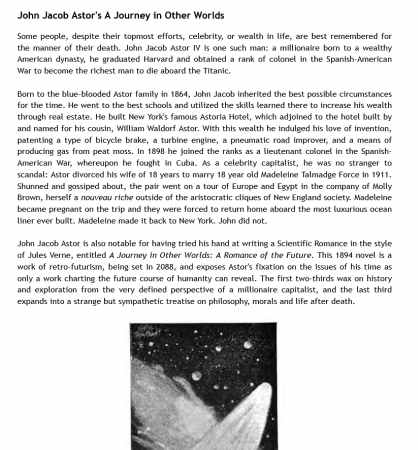
A Family's Haunted Past in the Desert Southwest
233 pages. Black-and-white photos/illustrations at start of each chapter. Family tree, acknowledgments, note on sources, bibliography, photography credits, and 'P.S.' section with author biography, Q&A with author, and author's description of her book.
What if your great-great-grandmother's ghost was haunting an historic hotel in Santa Fe, New Mexico?
That's the quest of the author – to learn more about her ancestor, to find out more about the world of ghosts, and to help her ancestor's restless spirit find peace.
The 'ghost' of the title is Julia Staab, born in Germany, who in 1865 married Abraham Staab, a German who had made a fortune in the dry-goods business in New Mexico Territory. He built her a magnificent mansion – which today is a hotel. She died in 1896, and she became a well-known ghost beginning in the 1970s.
The author weaves her story between historical research and spiritualistic investigations. She explains her original bias that Julia lived in an era when women were limited in opportunities, and probably under the tight control of her husband. She takes a ghost-hunting tour, meets a variety of psychics, and finally spends a night in the haunted bedroom.
The challenge is that so little information is available. Even when she discovers that Julia's daughter kept a journal, and it seems as if Julia's mysterious ailment is about to be revealed, it turns out that the daughter records only cryptic comments. Did Julia eventually develop a physical or mental disorder? Did she commit suicide? The final answer is that we don't know.
Then the author delves into the rumors that Julia had an affair with the first archbishop of Santa Fe. We're told that they were known to be friends, shared a love of gardening, spoke French together (he was from France, she had learned French as a child), and that Julia's family helped to fund the archbishop's dream, a cathedral. Then we're told a romance was unlikely, as he was much older than Julia and had no teeth! The author then submits to a DNA test to resolve the issue… and when the result suggests she has French ancestry, she ignores the result and changes the subject! (Unintentionally funny.)
The author also tells us about Julia's husband, his wealth and his political connections; she tells us about the lives of their children (providing evidence for a history of mental issues in the family). The Staabs were German Jews, and we learn what it meant to be Jewish in 19th Century Germany and in the Old West. In a moving chapter, we learn what happened to Julia's family that remained in Germany, that a few of them escaped with the help of their American relatives, but many perished in the Holocaust.
The book concludes with an experience with a psychic who claims to have released Julia's spirit from her torment.
Can you game it? This book provides useful background information and inspiration for Old West, Pulp, and horror gaming. There's even a stagecoach robbery.
I greatly enjoyed parts of this book. At times, the author's 'modern' assessment of 19th Century life was terribly annoying. I was surprised that the author, who admits to not being religious, spent so much time with psychics, and despite receiving contradictory (and some obviously false) information, took some solace there.
Reviewed by ![]() Editor in Chief Bill
Editor in Chief Bill ![]()
![]() .
.








